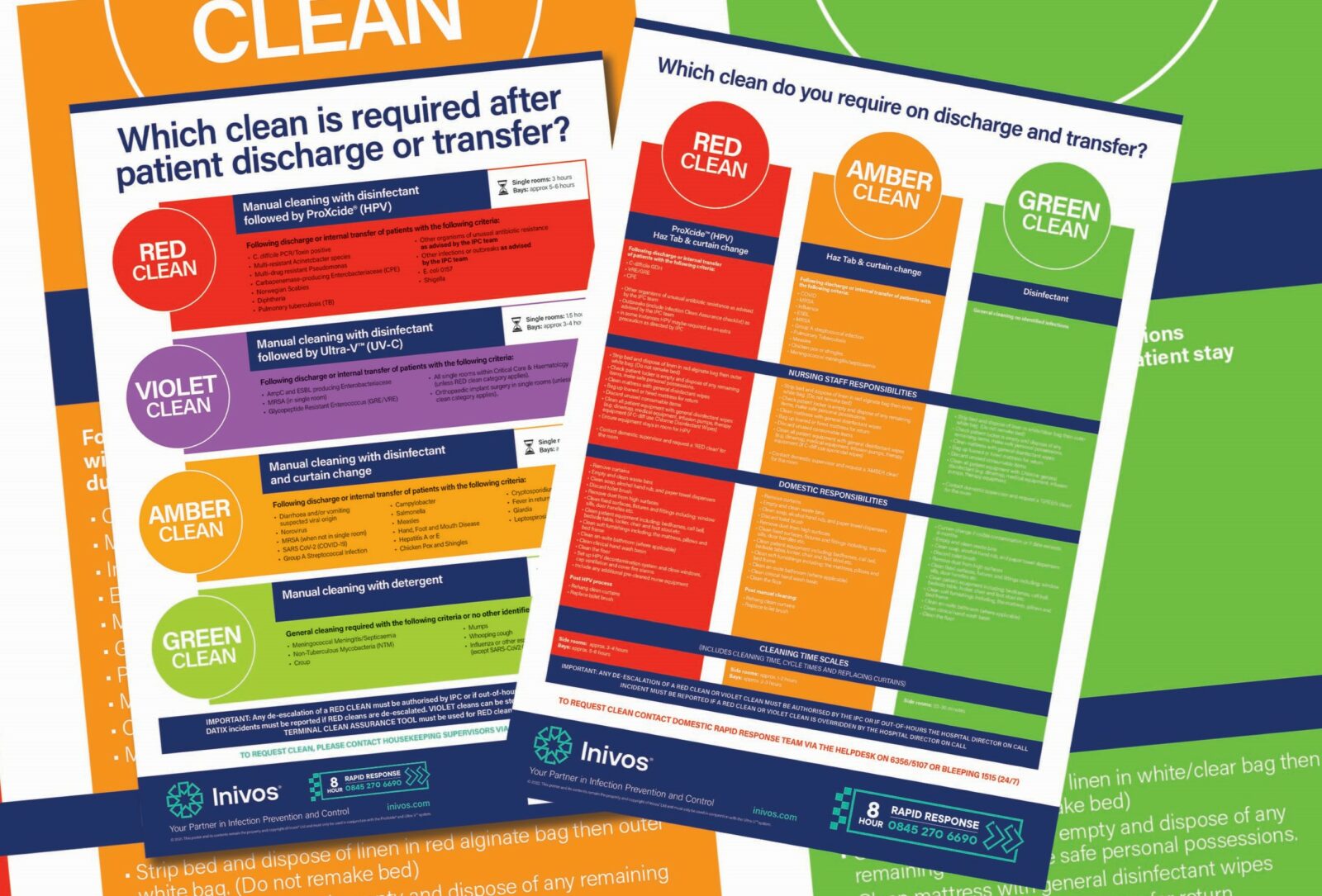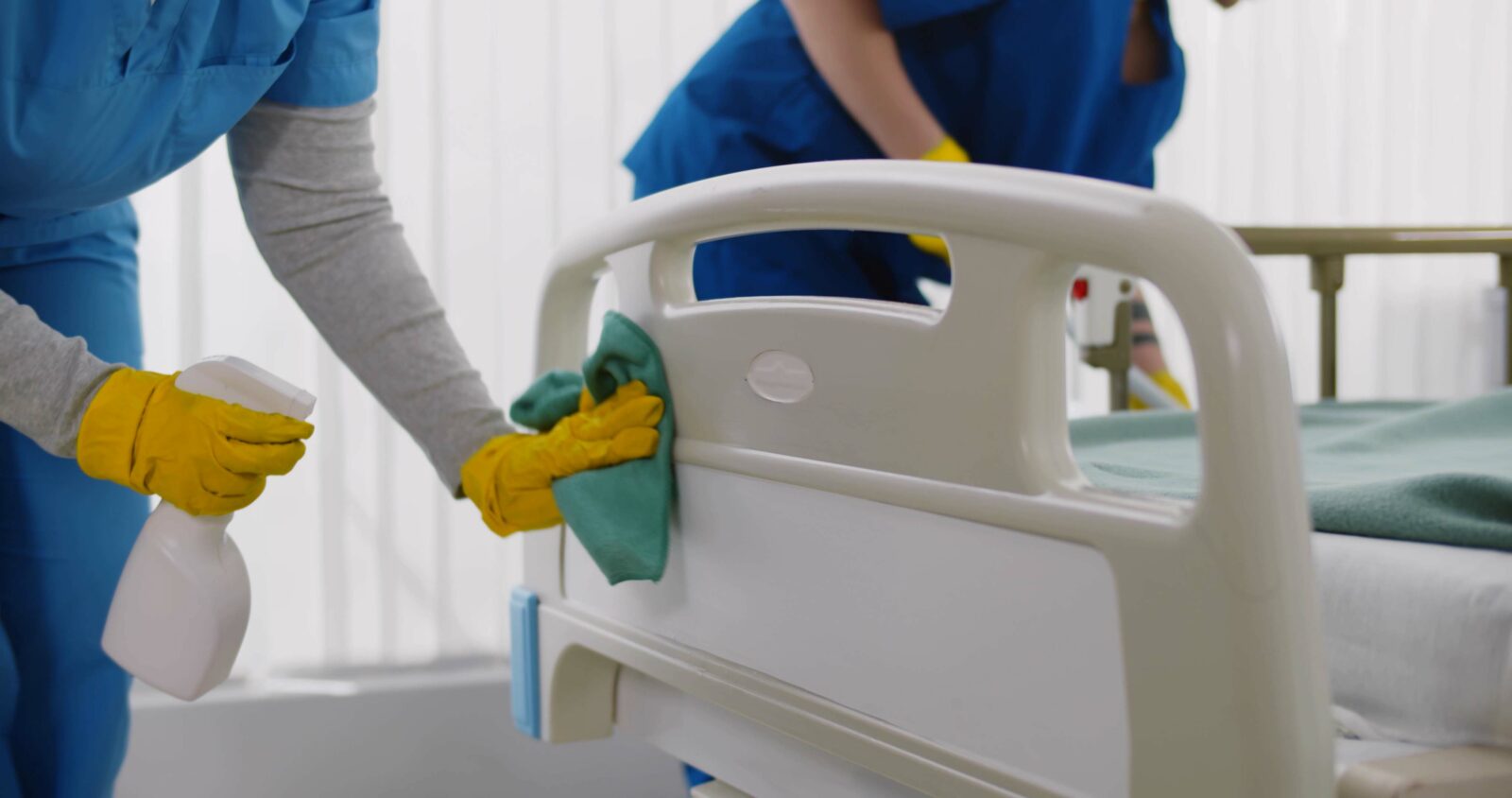
Guidance & Checklist for the Implementation of Ward Decant HPV or UV-C Deep Cleans
Environmental Cleanliness is a key infection control measure in the prevention of Healthcare Associated Infection (HCAI’s). Wards and departments must implement cleaning rotas, monitored by IP&C teams, but sometimes this isn’t enough. High-pressure environments, low staff numbers, and increased numbers of patients during the winter months takes its toll on effective cleaning, resulting in the transmission of pathogens such as Clostridioides difficile & Multi Drug Resistant organisms (MDROs).
Implementing a robust reactive deep clean strategy, utilising hydrogen peroxide and/or UV-C has been clinically proven to reduce rates of HCAIs and will mitigate the human factors associated with healthcare worker cleaning standards. Indeed, a systematic review by a Healthcare Infection Society Working Party: Automated room decontamination (2022), suggests the use of an automated decontamination device as a supplement to manual cleaning in the context of rising or high prevalence of nosocomial infection, such as C. difficile, meticillin-resistant Staphylococcus aureus, or vancomycin-resistant enterococcus.
The report goes on to say that hydrogen peroxide vapour or pulsed-xenon ultraviolet light in room surface decontamination should be considered during an outbreak of C. difficile infection when other modalities have failed to reduce acquisition.
Reactive Deep Cleans with HPV/UV-C
At times of high pressure a reactive strategy can keep patients safe and minimise impact on beds. In a nutshell – a reactive strategy (agreed at executive level) is an appropriate response when a patient with an alert organism such a C.difficile or MDRO is discharged or transferred to another healthcare setting. A reactive strategy will also include deep cleans associated with outbreaks. Such a strategy should be considered as a minimum standard with exec support needed to ensure it is robustly implemented.
The operational detail of such a strategy is beautifully described in the Inivos RAG poster – which gives clear checklists and guidance for healthcare personnel.

Proactive Deep Cleans with HPV/UV-C
Whilst this minimum standard will mitigate risk all year round – HCAI rates can be driven down further through the proactive implementation of decant ward cleans over the late spring/summer early autumn months. Easier said than done of course as winter pressures are now a year-round phenomenon!
Full ward decant cleans can be considered gold standard but are challenging to implement because of the need to protect bed capacity. Nevertheless, IP&C can think out of the box. Are there any decommissioned wards that can be brought back into use to facilitate a programme of cleans? Empty wards in other Trust/HB hospitals can be utilised too but will need robust cross working with other divisions/directorates. Although this sounds challenging – the benefits are tremendous – preventing harm to patients and outbreaks which impact bed capacity when wards need to be reactively closed.
Clearly a summer programme of full ward decant cleans needs Board approval and will need a concise business case/proposal to the Executive Team. Inivos experts can help with a business case – just ask!
If an empty ward proves to be a bridge too far then half ward cleans & bay cleans can be implemented bearing in mind that significant work will be undertaken in a functioning ward. Patient and staff safety will be paramount in such a setting.
Benefits of Proactive Ward HPV/UV-C Deep Cleans
It is truly remarkable that many households across the UK will spring clean their house on an annual basis – but the NHS struggles to implement a similar standard in hospitals despite extensive evidence that pathogens are endemic in clinical areas.
An empty (or half empty) decant clean offers so many benefits and provides an opportunity to:
- Inspect near patient equipment (particularly mattresses) – to establish whether it is fit for purpose.
- Condemn & remove furniture in a safe patient free environment.
- Declutter & HPV/UV-C deep clean all areas of the ward including corridors, offices & nurses stations (don’t underestimate what bugs are lurking on the IT equipment!)
- Inspect, maintain and deep clean other crucial areas including the dirty utility room, patient toilets and bathrooms.
- Address significant maintenance issues (many of which have health and safety implications) and decorate to dementia friendly standards.
All these benefits are in addition to a significant reduction in HCAIs, prevention of outbreaks, reduction in harm to patients and cost to the NHS.

Implementation of Ward HPV/UV-C Cleans
The benefits of deep cleans are clear – yet the process must be managed with precision and a great deal of planning to ensure the clean is conducted safely and efficiently.
Support from executive teams is crucial and full ownership taken by all healthcare workers involved is essential (see our previous article on this topic). The executive team may well be sceptical of implementing a programme – so your initial business case/proposal may focus on a few pilot deep cleans.
Patient & Staff Safety
As previously mentioned, patient & staff safety is paramount.
It is essential that all the Facility staff involved are appropriately trained in the use of steam cleaners (if used) and HPV and/or UV-C technology if an in-house model of cleans is adopted. Inivos will ensure that staff are appropriately trained in the use of HPV/UV-C and are signed off as competent.
Other H&S considerations relate to essential equipment such as defibrillators, cardiac arrest trollies and access to functioning oxygen and suction – which must be in place on the designated decant ward.
If half ward cleans are the chosen model of cleans it is essential that the ward is safely isolated from patients and ward staff.
It is absolutely crucial that Health & Safety personnel are consulted as soon as a programme of cleans is considered.
This downloadable checklist will support IP&C and Facility teams with this crucial process and is broken down into a strategic and operational checklist.
If the Executive Team at your Trust or Health Board have agreed to a programme of cleans, the strategic checklist can be skipped.
Summary
Implementing a programme of cleans is challenging but as described above the benefits for patients and the Trust/HB are tremendous.
If this is the first programme of cleans in the Trust or Health Board, staff may well be taken aback at the debris and condition of patient equipment. Photographs are important to document the process and will influence executives in implementing an annual programme of cleans. Surveillance data demonstrating a clear reduction in HCAIs will also support future cleans.
Lastly, Inivos has extensive experience in the implementation of HPV/UV-C deep cleans and can provide full support in the operational implementation of a programme.





